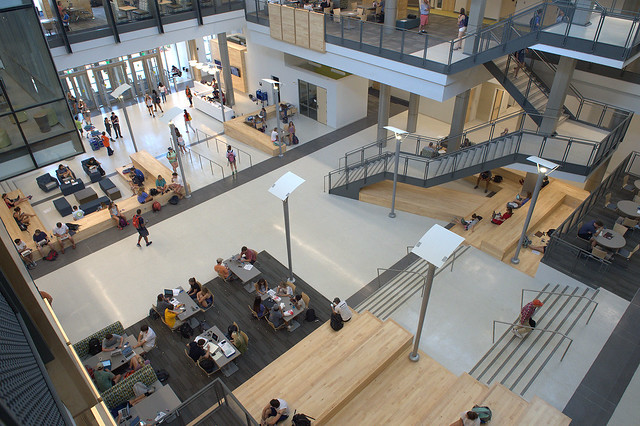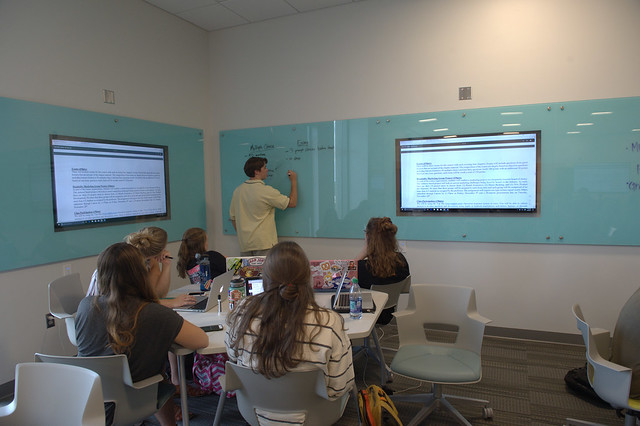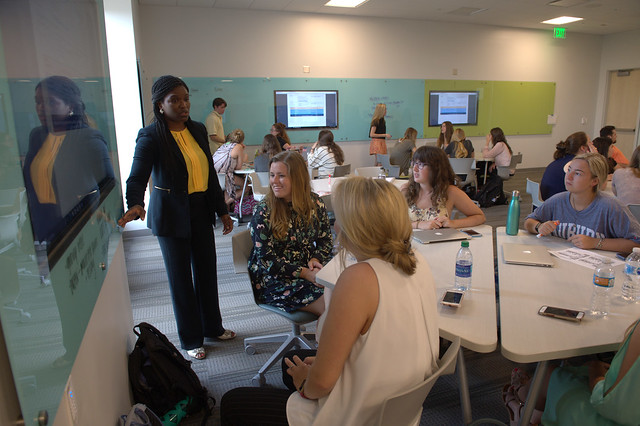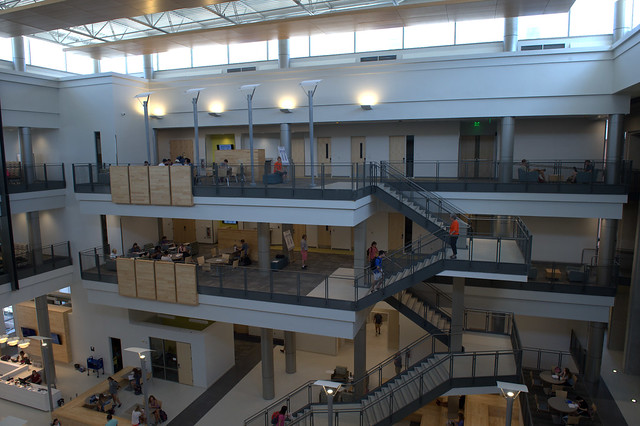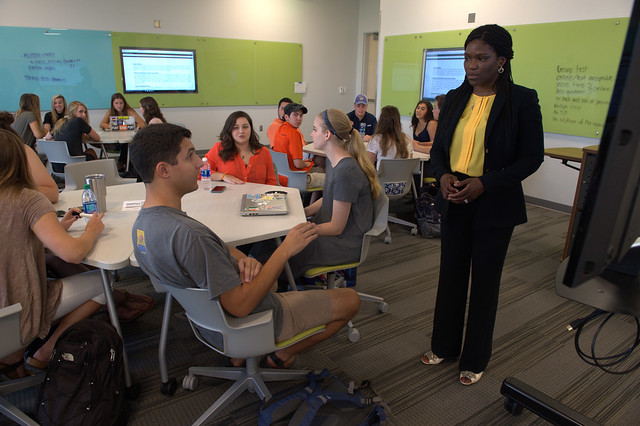Auburn University’s Mell Classroom Building engages students in learning
Article body
The energy in the Mell Classroom Building @ RBD Library is palpable. Auburn University's new classroom facility has been bustling with students and faculty during its first week, and the excitement about the new space likely won't be slowing anytime soon.
Throughout the building's three stories—all designed with Engaged Active Student Learning in mind—students are studying in common areas, chatting with each other, tucked away in corners reading and, most of all, soaking in everything Mell has to offer.
"It's exciting because there are people running into each other having interaction and conversations, learning new things from everyone," said Paige Coll, a junior studying secondary English and language arts education. "I believe Mell makes students more excited to learn, it makes it more fun, it makes it more engaging. The atmosphere in here is way cool."
Students enter the building from Mell Street and immediately find themselves in a three-story atrium that sits on what was once the plaza in front of the Ralph Brown Draughon Library. It's hardly recognizable as that space anymore, except for the original towering columns that make up the façade of the library are still in place.
Connected to the library
When Auburn University committed to building the $35 million, 69,000-square-foot, active learning facility, proximity to the Ralph Brown Draughon Library was a priority. In order to offer students a place for engaged learning and then encourage those classroom dialogues to continue in study spaces, the facility needed to be as close as possible to the library. As it turns out, constructing the building onto the front of the library and merging the two spaces as one seemed to be the best solution.
"What's awesome is there's a bridge connecting the two, and in some of the classrooms on the third and fourth floor there's an exit door inside those classrooms to get to the study spaces inside the library," Coll said.
Long before the doors of Mell opened, informal study spaces were being added to the library. Now there are informal and formal spaces in both buildings, and students can use an online system to reserve the formal study spaces.
The idea behind the setup is simple: Students can leave a classroom where they were engaged with their peers and go straight to a study space to continue the dialogue, study individually or even meet with a professor after class.
"Students come early and they don't want to leave the spaces. When they walk out of the classrooms, there is not an immediate rushing out of the building, but they plop down, they hang out for a little while, they may be talking with their instructor," said Wiebke Kuhn, learning spaces and faculty development coordinator for the Biggio Center.
Ralph Brown Draughon Library is home to a variety of student services—Academic Support, ePortfolio Project, Miller Writing Center, Study Partners and more.
"I think it creates a really nice synergy allowing the students to have that immediate connection with all of these support services," Kuhn said.
Inside the classroom
Inside the walls of the 26 EASL Classrooms is where the learning happens—and it's a different style of learning than most college students would expect. Rather than rows of desks with a professor lecturing at the front, students are grouped in clusters and surrounded by technology.
As students gather in clusters or pods, they work together to solve problems, find solutions and teach each other. As with any college class, preparation ahead of time is key. But, in EASL classrooms, it's absolutely necessary for success.
"Being able to talk with my classmates, I might be thinking one thing that the professor said but other people will be saying different things so we can work together as a group to better understand the material," said Logan Holyfield, a sophomore in pre-business.
She said working with other students and having the ability to display and share her work with her peers gives her confidence that she is understanding the material.
"If you're coming in prepared, you can write on the boards or write over the monitors in some of the classrooms, so it just lets you touch the material more and you can definitely get more retention from it," Holyfield said.
It's not just a new experience for students, though. Professors have adapted lesson plans and even taken courses themselves to prepare to teach in the Mell Classroom Building.
"The classrooms give a great flexibility for that student-to-student interaction to happen and then also that faculty-to-student interaction to happen, and actually all three at the same time, the faculty working with one student working with another student," said Steve Duke, associate professor in the Samuel Ginn College of Engineering.
Those interactions in the classroom, Duke said, help students learn the material faster and retain it for longer.
"I think students realize this is truly about my learning as a student and I think active learning is positive in that way," he said.
John Gorden, associate professor of chemistry, equates teaching in EASL classrooms with improvisation in acting. He can prepare for the class and know what material needs to be covered, but the direction each class session takes can be determined by the students.
"I have to relinquish control of my classroom to the students, and that is exciting and challenging and scary all at the same time," Gorden said. "I have to trust my students to follow with me through this and still maintain the level of standards and rigor that are required to be successful after this course."
Getting students to "buy in" to the idea of engaged, active learning is critical, Gorden said.
"Lots of data and scientific research shows that, while we all learn differently, students tend to retain things more efficiently when you hit more than one of the senses simultaneously," Gorden explained. In an active learning classroom, a professor can do just that by allowing students to hear the material, see it on a screen, write it out for their peers and even explain it.
"I get immediate feedback from my students, whether I want it or not, by being engaged with the students and having these students be engaged with each other," he said. "If I'm not clear with them, they're going to communicate that back to me."
That immediate feedback allows Gorden to ensure the students are comprehending the material being taught.
"One of the aspects of active learning is to try to get the students to take ownership of what they don't know so they can identify what they are comfortable and confident with," Gorden said. "Part of it is getting the students to be engaged and attentive, and the other part is getting them to recognize, 'Hey, if I come to class prepared, I will get more out of the dialogue that I'm involved in.'"
Immersed in technology
All of the classrooms in the Mell Classroom Building are high-tech, allowing students and professors to incorporate technology into every learning opportunity.
Three levels of technology exist in Mell. The first level, the most basic one, is glass boards, which are in every classroom except the lecture halls.
"We have glass boards all around the room and students can write on those with dry erase markers, faculty can write on them with dry erase markers and some of the rooms have a lot of windows that are made of glass as well that can be written on," Kuhn said.
The second level of technology allows faculty members to have four different ways to bring content to students. They can use the computer in the classroom, bring their own laptop, use the document camera in the room or use ShareLink, a technology that allows any mobile device to be connected wirelessly to the projections system in the room.
In most of the rooms, that means one projector that a faculty member can connect to, but in the third level of EASL classrooms, the technology is even more advanced. In those rooms, individual student pods each have their own monitor associated with it, along with sharing technology associated with each monitor.
"Faculty members can give control of their classrooms over to the students," Kuhn said. "Each student can connect wirelessly to the monitors, share their devices, work on research, writing assignments, drawing assignments, whatever it is that they need to do."
The two lecture halls in Mell hardly meet the definition of a lecture hall. They're each built in tiers that have two rows of tables per tier and free moving chairs, allowing students to turn around and work with others in the class. Sharing technology is also installed in the lecture halls.
For most college students, the technology is second nature, so being able to use it enhances the classroom experience.
"I'm definitely more engaged in these classrooms," Coll said. "There's more discussion that's allowed in these classes, there's more collaboration. It's definitely a better environment for learning."
Related Media
Related Links
Media interested in this story can contact Communications Director Preston Sparks at (334) 844-9999 or preston.sparks@auburn.edu.
Auburn University is a nationally ranked land grant institution recognized for its commitment to world-class scholarship, interdisciplinary research with an elite, top-tier Carnegie R1 classification, life-changing outreach with Carnegie’s Community Engagement designation and an undergraduate education experience second to none. Auburn is home to more than 30,000 students, and its faculty and research partners collaborate to develop and deliver meaningful scholarship, science and technology-based advancements that meet pressing regional, national and global needs. Auburn’s commitment to active student engagement, professional success and public/private partnership drives a growing reputation for outreach and extension that delivers broad economic, health and societal impact.



